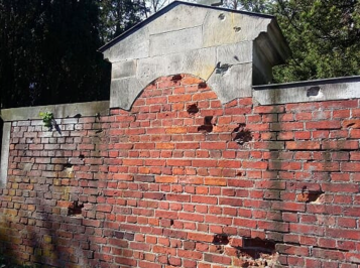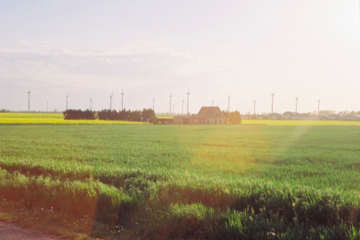Traces of war and the presence of the dead: Reflections on ethnographic fieldwork in eastern Germany
All names have been changed to protect the anonymity of interlocutors.
If I asked you in what ways the Second World War continues to be ‘present’ in our time, you may think about the harrowing witnesses of survivors, or the stories you heard from your parents and grandparents. More abstractly, you may think about the current geo-political order, or the rise of neo-nationalisms that often evokes (not always justified) analogies to another period in the history of Europe.
In Brandenburg (eastern Germany, former GDR), the presence of WWII is not abstract in the least. The region was heavily affected by the Soviet Offensive of 1945, and tens of thousands lost their lives in Germany’s desperate resistance to the advance of the Red Army. For 75 years now, the bodies of the dead have been resurfacing, together with personal objects, tons of ammunitions, and weapons big and small. It is in Oderbruch, at the border with Poland, that I lived for 15 months, conducting ethnographic fieldwork as part of my PhD in social anthropology. I had come there to address the political question of how people deal with the resurfacing and presence of a particularly controversial category of dead bodies: those of German soldiers. How does one ‘commemorate’, I wanted to know, a group of people that has become synonymous with the crimes and expansionistic ambitions of the Third Reich? As it is always the case, fieldwork revealed a much more nuanced reality beyond the merely political one. Interviews, information from GDR archives, but also attending all sorts of unrelated social and cultural events, and participating to campaigns of search and exhumation organised by volunteers, showed clearly that ‘memory’ and politics are only two aspects of a much more complex phenomenon.
Today, the landscape of Oderbruch appears peaceful, and its forests and riverside views make it a favourite destination for cyclists.
Yet, on a closer look, the war retains a distinct presence, and certainly not within the walls of a memorial or a museum. Digging in the earth only a few centimetres deep will soon reveal rusty pieces of metal. Dangerous ammunitions also litter the soil, and many continued to die for touching them years after the war. Whenever houses and streets are built, people say, bomb disposal units have to be present. As I drove through the countryside on the way to meetings, interviews, and social events, vans of bomb disposal units were a common sight, or could be seen at work at the side of roads. Many have stories about clearing ammunitions from their properties, and my interlocutors’ narrations of growing up in the GDR always highlighted the presence of war materials, that children would make explode like fireworks. “It is our collective history” one man said “of our generation”.
The landscape too still bears very visible marks of the war: shrapnel holes can be seen on houses, walls, and graves, and explosion craters or the remains of trenches are still recognisable in the soil. Such “traces” are not packaged, memorialised, and turned into ‘heritage’ like in other musealised former battlefields, but rather treated with an ethos of obviousness, as everyday sights being just there.
Another resurfacing, sadly common, is that of the remains of soldiers. They emerge in their hundreds every year from fields, construction sites, and private gardens. In a war in which the space of combat and that of civilian life merged powerfully, as the war was fought house by house, and field by field, the dead lay scattered everywhere after the war, and they were often thrown back into trenches and craters, or buried in every free surface in towns and villages, and covered up. With some notable exceptions, the dead were never really systematically searched for, recovered, and identify on a large scale. This was especially the case for the German soldiers: with the end of the war, East Germany became part of the Soviet bloc. The newly-established socialist GDR firmly claimed discontinuity with the ‘Germany’ that had brought so much destruction upon the world. This meant firmly disowning the remains of the German dead, the despised members of the criminal Wehrmacht. Some of my interlocutors pointed to the evident paradox: virtually all (East) German men had fought in the army, yet their survival guaranteed them the possibility of reinventing themselves as citizens of the GDR, while their dead comrades remained stuck in the haunted category of criminals. Thus, except for some activities of reburial, carried out under the protection of the Evangelical Church, the dead were often left where they had fallen, in covered-up trenches and bomb craters. Any form of public mourning was looked down upon, was monitored, and could have led to prosecution. A most common statement in my fieldwork was that “in the GDR, German war dead were a taboo”.

Yet, the official mismanagement and invisibility of these dead, evident from archival sources, contrasted starkly with the physical presence of human remains and scattered graves in the everyday lives of the people. My research revealed that the engagement with these remains, far from being exclusively political or the object of ‘memory politics’, gave rise to various creative practices through which people kept on caring for and protecting these bodies. Ernst, for example, worked at the digging of ditches in the countryside. He and his colleagues had an informal agreement with a local mayor, who would let them bury the dead anonymously in the cemetery while she was on holiday. Joseph, instead, saw how a Soviet helmet had been place placed on a German grave to prevent the removal of the grave. The inhabitants of a village, on finding a soldier near a street, quickly reburied him on the spot to prevent the dispersal of the bones by the authorities – the body was then exhumed and reburied after the Reunification.
People also emphasised the enduring presence of these remains in everyday life: every village has war graves, they said, and in every village “women” who had lost their husbands or sons at war would take care of the war graves of strangers. Some mentioned taking care of the graves of soldiers while watering those of their kin, thus routinising care for strangers into that for one’s own family. Anthropologists are particularly interested in these practices, as they show that relatedness is not exclusively a matter of consanguinity, and that affective ties can be established among the living and the dead.
Despite the war and the dead are a very concrete reality for people in Brandenburg, few, outside from local inhabitants, are aware of this phenomenon and history. While many know about the common graves of the Spanish Civil War, most, including Germans, ignore that in the ‘East’ the dead continue to be searched, found, and reburied. Like in a village not too far from Frankfurt an der Oder, where for years now an international association of volunteers continues to look for soldiers, both Soviet and German, not exclusively out of archaeological interest but to identify them, rebury them, and reconnect them to their families. There, another group of volunteers is also building a memorial dedicated to both Soviet and German casualties.
It has become a commonplace, in German media and academia, to state that the past is ‘remembered’ differently in eastern and western Germany, and that the fall of the Berlin Wall did not even out differences between the respective ‘mentalities’. The ‘difficult past’ of both WWII and of the reunification has been entrenched in two hegemonic discourses: the psychological one of trauma, and the political one of representation. Indeed, the recent rise in far-right parties in the German East, which I witnessed from the field with the regional elections of 2019, is attributed, among many other things, to a not-sufficiently elaborated relationship with the Nazi past, or the not-sufficiently elaborated consequences of the German reunification. Yet, ethnographic fieldwork reveals a much more complex reality, one in which politics are only one aspect of the question, and complex and ambiguous emotions of condemnation, care, and pity towards the dead and the past at large can exist at the same time.
Laura Tradii is a PhD candidate in Social Anthropology at the University of Cambridge. You can read more about her work and projects here.



